Jan 25, 2018 Nikola Budanovic Reprinted from The Vintage News – Jan 26, 2018
First, an answer to a question. Magna Carta Panels; “Get out and get under” photo. Yes, it is unusual to have to do this. It is sometimes necessary when repairing old textiles that cannot be rolled onto the wooden frame bars. In the case of the panels, my guess is that there was something not quite right about some stitching in the central area that needed some attention.
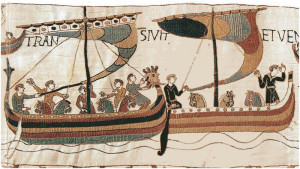
For the first time in 950 years, the famous Bayeux Tapestry will leave its home in France and head for England. The Bayeux Tapestry is one of the artistic wonders of the Middle Ages, depicting the Norman invasion of Britain, the Battle of Hastings, and the subsequent rule of William the Conqueror.
Notice the wind in the sails and the horses marveling at sailing on the sea. Also, that everything, in all these pictures, is proportionally correct and balanced. Then, go and take another look at the battle scenes. The picture below does not show the proportion distortions.
The 224-foot-long panorama, which serves as a priceless piece of history, is currently located in Bayeux, a town in Normandy. A recent announcement by French President Emmanuel Macron that the delicate artifact will be loaned to England has created much excitement and debate on both sides of the English Channel.
The tapestry was originally woven in Kent, in southeast England, somewhere around 1070, by the order of Bishop Odo, William’s half-brother, who intended to use it solely for its narrative potential―after William I made a foothold in England, he claimed the English throne. The tapestry was meant to justify his attempt as legitimate, as he was the victor at Hastings.
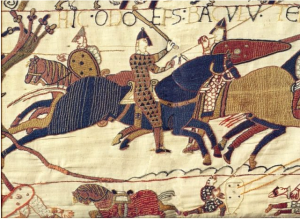
A segment of the Bayeux Tapestry depicting Odo, Bishop of Bayeux, (with his bludgeoning mace) rallying Duke William’s troops during the Battle of Hastings in 1066.
The Battle of Hastings was one of the turning points in British history; the defeat suffered by the Saxon King Harold marked the beginning of the Norman period in Britain. The landowning elite were completely replaced by Norman royalty, and so was the culture and the language―Old English was all but lost as a literary language throughout the 11th and 12th century.
William the Conqueror established his rule, but it was plagued by decades of rebellions, uprisings, and civil wars. Even though he crowned in 1066, it was not until 1072 that William’s grip on the country was firm.
The craftsmen who produced the work almost 1,000 years ago remain unknown, but their work is anything but. The tapestry is considered to have exquisite artistic value, as well as historic. The depictions of the horrors of war, which include headless soldiers, King Harold being shot in the eye with an arrow, dead horses, and Normans burning and pillaging villages might be the first ever to challenge the chivalrous image of the period.
It still uncertain which museum will take responsibility for housing the relic. The British Museum in London was cited as the initial host, while the English Heritage Museum, which owns Battle Abbey, built by William himself to commemorate the Battle of Hastings in 1066, claims that the tapestry should, at least temporarily, be displayed at the place where the historical battle actually took place.
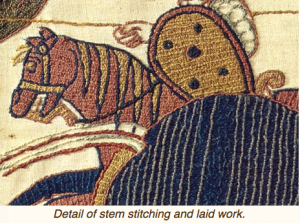
The loan is scheduled for the year 2022, when restoration of the Bayeux museum in France will take place. So the tapestry would be sent for safekeeping, but the transport itself is a tricky issue. The millennium-old embroidered cloth is very fragile and the risk of damaging it during transport looms over Macron’s decision.
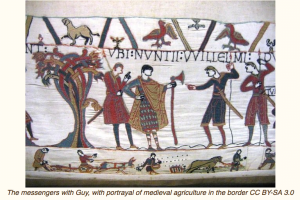
The current curator of the tapestry, Pierre Bouet, stated for the Guardian that, at first, he considered the news was a hoax, but when it proved to be true, his skepticism increased: “If you were to ask my advice, despite the regard I have for my English colleagues who I have worked with for many years, I would say no.”
On the other hand, both the Heritage Museum and the British Museum are thrilled with the prospect of the return of the medieval masterpiece to England. Rowena Willard-Wright, a senior curator at English Heritage, implied in her interview for the Guardian that the tapestry should be located outside London:
“The problem for the British Museum is what you might call the Tutankhamun effect: people end up queuing all the way into Russell Square. If people have to queue, where better than the Sussex countryside?”
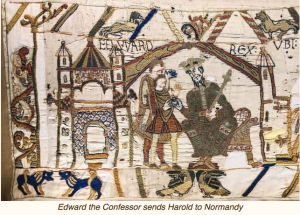
The staff of the British Museum consider the 70-meter-long panorama too fragile to be moved from one place to another, and that it would be safest to keep it in one place. Michael Lewis, a curator, claims that conservation and practical difficulties would make the tapestry impossible to tour.
Related story from us: Off to the ‘holy places’: pilgrimages during the Middle Ages
However, the British Museum in London considers the artwork pivotal and would like to make it accessible to as many people as possible. The decisions on where it will be housed, and even if safe transportation will be possible, are yet to be made. Until then, the tapestry remains exhibited in the Bayeux city museum, in the picturesque countryside of Lower Normandy’s department of Calvados.
This is all very exciting and not even contemplated publicly when I started writing this sequential account of Embroideries that Record History. I will be taking a further look at the resurgence of Large Embroideries in future postings.
This is all very exciting and not even contemplated publicly when I started writing this sequential account of Embroideries that Record History. I will be taking a further look at the resurgence of Large Embroideries in future postings.
It is time for me to return to stitching which has been neglected lately. I hope that you have enjoyed reading and seeing these photos and videos. I have tried hard to be accurate but have undoubtedly made errors all of which were unintentional.
Comments are welcome, bye for now, Ann B.
This looks wonderful! Great work Ann, you are very talented!
This has been such an exciting series of blogs. I have enjoyed and learned much of British history as well as marvelling at the artistry and craftsmanship of the tapestries. Many thanks Ann.